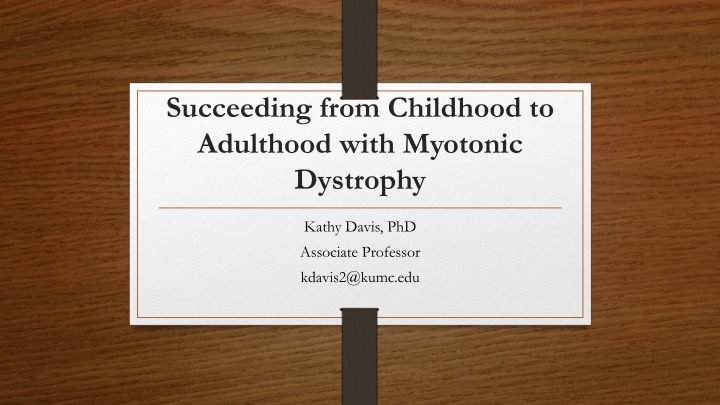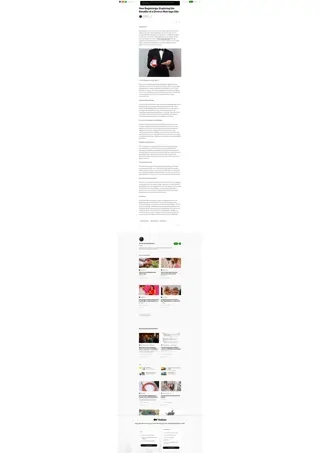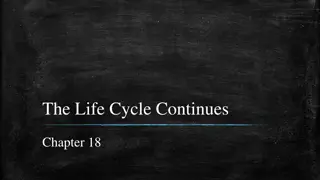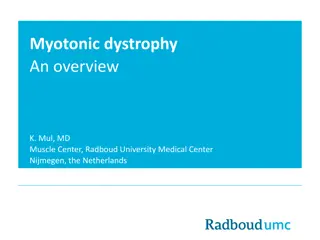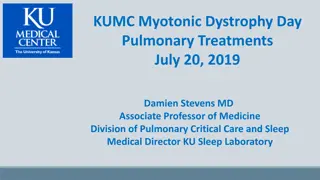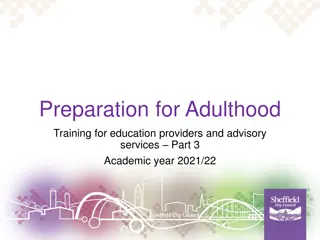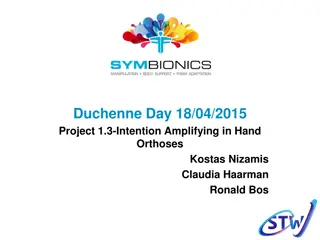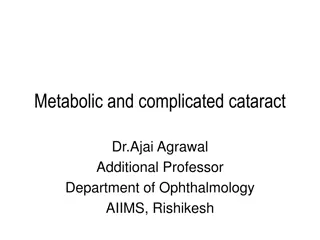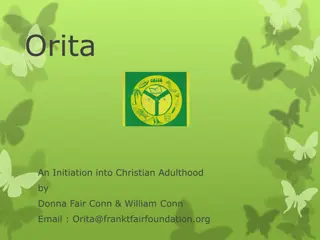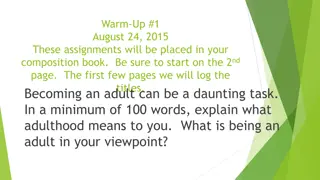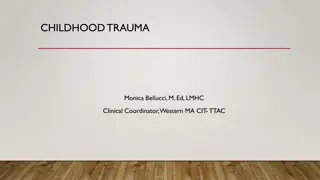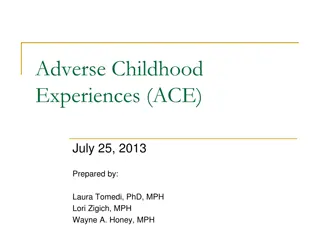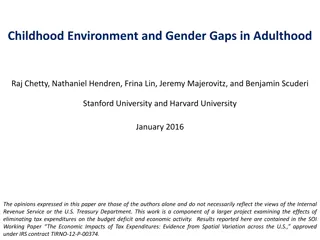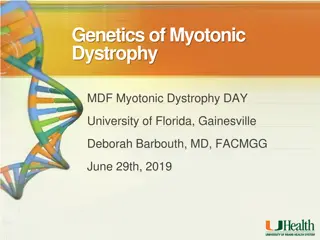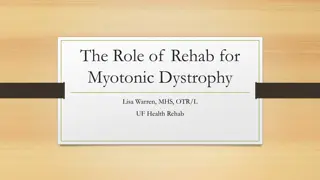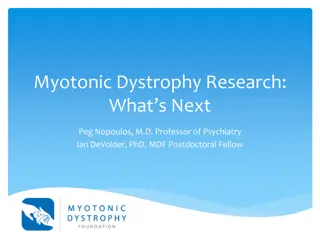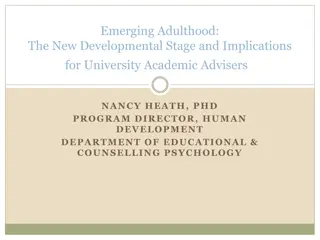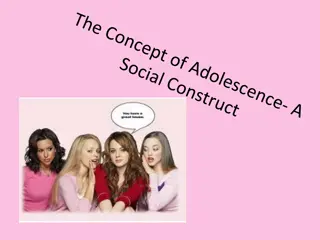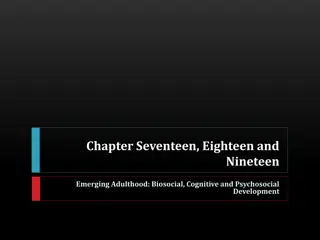Navigating Myotonic Dystrophy from Childhood to Adulthood: Insights and Guidance
Understanding the journey of individuals with Myotonic Dystrophy through education laws like IDEA and Section 504, focusing on transition, support services, and essential categories and concepts. Explore how Individualized Education Programs (IEP) and Section 504 cater to academic needs, ensuring equal opportunities for those with disabilities.
Download Presentation

Please find below an Image/Link to download the presentation.
The content on the website is provided AS IS for your information and personal use only. It may not be sold, licensed, or shared on other websites without obtaining consent from the author.If you encounter any issues during the download, it is possible that the publisher has removed the file from their server.
You are allowed to download the files provided on this website for personal or commercial use, subject to the condition that they are used lawfully. All files are the property of their respective owners.
The content on the website is provided AS IS for your information and personal use only. It may not be sold, licensed, or shared on other websites without obtaining consent from the author.
E N D
Presentation Transcript
Succeeding from Childhood to Adulthood with Myotonic Dystrophy Kathy Davis, PhD Associate Professor kdavis2@kumc.edu
Key Concepts Individuals with Disabilities Education Act (IDEA) Section 504 of the Rehabilitation Act (504 Plans) Vocational and Rehabilitation Services (Voc Rehab or VR) Transition: from Pediatric to Adult Medicine
Individuals with Disabilities Education Act ensures students with a disability are provided with Free Appropriate Public Education (FAPE) that is tailored to their individual needs. Part C ages birth 2 (Infant-Toddler Services) Part B ages 3-21 (Early Childhood Special Education and school age)
Individuals with Disabilities Education Act What it is IDEA Qualifying
13 categories - IDEA Orthopedic impairment Other health impairment Specific learning disability Speech or language impairment Traumatic brain injury Visual impairment (including blindness) Autism Deaf-blindness Deafness Hearing impairment Emotional disturbance Intellectual disability Multiple disabilities
B. Which adversely affects academic performance
IDEA Making it work Individualized Education Program (IEP) Is it working for you, for your child? Special education teacher Principal Director of special education State Department of Education
Section 504 Civil Rights legislation (1973) No $ to fund; $ in penalties for not funding Persons cannot be discriminated against on the basis of a disability Disability defined under Section 504: has a mental or physical impairment, has a record of impairment or is regarded as having such an impairment Federal government considers students as disabled if they are substantially limited in their major life activities such as (but not limited to) self-care, breathing, walking, seeing, performing schoolwork, speaking and learning.
Section 504 Provides accommodations, not special education Preferential seating Quiet area for test taking Extra time to complete assignments Rest period in the nurse s office Special bus transportation Someone to push their wheelchair during marching band
504 and Higher Education Intention was to impact employment for people with disabilities First legislation that provided equal access for students with disabilities Accessible programs Students who need accommodations must initiate the process May require medical documentation of diagnosis, functioning Must make reasonable accommodations
Vocational and Rehabilitation Services
Voc Rehab (VR) Vocational Rehabilitation Services (VR) provides quality individualized services to enhance and support people with disabilities to prepare for, obtain or retain employment. Vocational rehabilitation programs are custom-designed for each individual. Services: assessment services, counseling and guidance, training (school), job related services, rehabilitation technology (assistive technology), independent living, and a variety of support services. http://www.parac.org/svrp.html
Eligibility for VR If a VR counselor determines that you meet the following three conditions: You have a physical or mental disability. Determined by medical records or by completing tests, exams, or evaluations to verify the disability. Your disability prevents you from getting or keeping a job. You require vocational rehabilitation services to get or keep a job that matches your strengths, resources, priorities, concerns, abilities, capabilities, interests, and choices.
SSI and PASS Social Security Income - pays monthly benefits to people with low incomes and limited assets who are 65 or > years, are blind, or have other disabilities. Parents assets considered for SSI until the child turns age 18. Plan for Achieving Self Support (PASS) - student is able to set aside income and resources that are being used toward a specific vocational goal (such as college tuition) and still receive SSI payments. However, be aware that earnings from employment may affect SSI benefits. http://www.ssa.gov/disability/
Transition Should start at diagnosis always thinking of preparation for adulthood. Courses, interventions and significant life milestones. Medical transition From pediatrics to adult provider Social transition to independent living and full societal inclusion Involving patient and parents in decision making. Transition to spouse and patient. Patient advocacty groups
3-Ps of Transition 1. People (patient) focused peds and adult team meet with patient/family. Beyond medical needs focus on the whole person Seminars to address college, personal care, dating, etc.
3 - Ps of Transition 2. Process-focused Tracking systems to inform docs/track progress over time Identifies when patients are transition ready Ensures important information such as self-advocacy skills, health insurance planning, etc. are part of EMR
3 Ps of Transition 3. Performance-focused Transition is more difficult due to challenges including fewer adult providers, insurance complications, etc. the purpose of transitioning patients can get lost in the shuffle . Transition improves patient care and quality of life (QoL) so it is important to do it right. Providers much work hard to ensure patients needs and QoL are addressed (sexual health, dating, independent living, etc.).
Palliative Care It is NOT your grandma s palliative care!~ Different focus with young people Quality of life Enhancing opportunities Development across all spheres: social, emotional, cognitive, comfort with friends, etc. Enabling the young person to be all that they can be
Resources https://www.mda.org/young-adults https://www.mda.org/young-adults/resources http://quest.mda.org/news/thinking-college-think-scholarships http://www.myotonic.org/sites/default/files/Financial%20Resources%20fo r%20Families%20with%20DMPDF_1.pdf https://www.scholarships.com/financial-aid/college- scholarships/scholarships-by-type/disability-scholarships/
Please contact me or come to MDA clinic (on a day I am there!) Kathy Davis, PhD Associate Professor of Pediatrics Director, KU Kids Healing Place 3901 Rainbow Blvd. MS4004 Kansas City, KS. 66160 kdavis2@kumc.edu 913 588 6305
